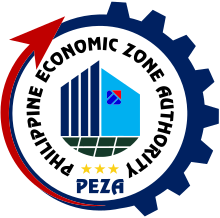Philippine Economic Zone Authority
 | |
| Agency overview | |
|---|---|
| Formed | June 21, 1969 |
| Preceding Agency |
|
| Jurisdiction | Philippines |
| Agency executive |
|
| Parent department | Department of Trade and Industry |
| Website | www |
The Philippine Economic Zone Authority (PEZA), formerly known as the Foreign Trade Zone Authority (FTZA) and Export Processing Zone Authority (EPZA), is a Philippine government agency attached to the Department of Trade and Industry.
It was created to help promote investments in the export-oriented manufacturing industry into the country by assisting investors in registering and facilitating their business operations and providing tax incentives.[1] PEZA also assists investors who locate in service facilities inside special economic zones in the country (areas are called PEZA Special Economic Zones) which are usually business process outsourcing and knowledge process outsourcing firms. Other activities also eligible for PEZA registration and incentives include establishment and operation within special economic zones for tourism, medical tourism, logistics and warehousing services, economic zone development and operation and facilities providers.[2]
History and organization
[edit]On June 21, 1969, Congressman Pablo Roman, Sr. authored Republic Act 5490 designating Mariveles, Bataan as the first free trade zone in the Philippines. It also created the Foreign Trade Zone Authority (FTZA).
In early 1972, three congressmen — Roman, Roces, and Sarmiento - sponsored the bill to convert the free trade zone authority into government corporation. This would grant the power of a corporation combined with the coercive strength of the Philippine Government to move the project ahead, especially regarding the relocation of residents. The bill stalled in Congress due to the opposition of many members to the vested interests involved.
On November 20, 1972, the Bataan Export Processing Zone (BEPZ) (later Freeport Area of Bataan (FAB) since October 23, 2009, with the name was concurrently used with the BEPZ/Bataan Economic Zone (BEZ) names as the zone's secondary name when Authority of the Freeport Area of Bataan (AFAB) partially operated and managed the zone along with PEZA as the latter still had remaining programs and plans over the zone for eight months from October 2009 until the abolishment of BEPZ/BEZ on June 30, 2010 as a result of the full turnover of the zone's operations and management from PEZA to AFAB the day before on June 29) became the first official economic zone in the Philippines through Presidential Decree 66. The BEPZ was one of the most progressive communities in Luzon during its first decade of operation. The area attracted over one hundred multinational locators.
In 1979, President Ferdinand E. Marcos Sr. signed Proclamation Nos. 1811 and 1825[3][4] which established the Mactan Export Processing Zone (MEPZ) in Mactan, Cebu and the Baguio City Export Processing Zone (BCEPZ) in Baguio City. The Cavite Export Processing Zone (CEPZ) was then later created on May 30, 1980 through Proclamation No. 1980[5] followed by the Pampanga Export Processing Zone (PEPZ) on June 05, 1981 through Proclamation No. 2089, s. 1981.[6]
On February 21, 1995, EPZA became PEZA due to the enactment of Republic Act 7916 which was passed by the House of Representatives and the Senate and approved by former Philippine President Fidel V. Ramos.[7] As provided in the Special Economic Zone Act, the PEZA Board is chaired by the Secretary of the Department of Trade and Industry. Vice-Chair is the Director General (Chief Executive Officer) of PEZA. Members of the Board are Undersecretaries representing nine (9) key government Departments, to ensure efficient coordination between PEZA and their respective Departments on matters pertaining to investors' operations inside the Special Economic Zones. PEZA inherited the three public ecozones under EPZA. PEZA acquired Pampanga Economic Zone in 2003.[8]

The Bataan Economic Zone (BEZ) converted into FAB on October 23, 2009 was separated from PEZA when it fully turned over the zone's operations and management to another government agency Authority of the Freeport Area of Bataan (AFAB) on June 29, 2010 at 1:25 pm one day before the end of administration of President Gloria Macapagal Arroyo and her successor Benigno Aquino III became President of the Philippines which completed all of PEZA's remaining programs and plans on the zone resulting to the abolishment of BEPZ/BEZ the following day on June 30. This change was reflected when AFAB removed the PEZA and BEZ name and logo on the zone's administration building and a welcome sign along Roman Superhighway which made the red part of the BEPZ/BEZ/PEZA logo became all blue on late August 2010 as one of the projects of AFAB made during its first few months of operation and management over the zone and then the said logo was next to be removed by placing a cement on a part of the building where the logo is in 2012.
Despite the full turnover of the zone from PEZA to AFAB resulting to the subsequent abolishment of BEPZ/BEZ on June 30, 2010 after eight months of AFAB's partial operation and management from October 23, 2009 to June 29, 2010, there are still traces and references of BEPZ/BEZ and PEZA still left that were not yet removed, such as on some signages found on Mariveles Zigzag Road and on a newer welcome sign located after the zone's another sign with a guard house along the said highway. The BEZ sticker is still effective until FAB started to issue its own sticker in 2011 which succeeded the former. FAB initially had 39 enterprises and 12,777 workers by the time of turnover of the zone's full operations and management from PEZA to AFAB which inherited from its predecessor BEZ.[9][10][11]
Incentives
[edit]PEZA offers both fiscal and non-fiscal incentives as well as ready-to-occupy business locations in world-class economic zones and IT parks or buildings. Fiscal incentives include: income tax holiday for a certain number of years, which translates to 100% exemption from corporate income tax; tax and duty-free importation of raw materials, capital equipment, machineries and spare parts; exemption from wharfage dues and export tax, impost or fees; VAT zero-rating of local purchases subject to compliance with BIR and PEZA requirements; exemption from payment of any and all local government imposts, fees, licenses or taxes; and exemption from expanded withholding tax. Non-fiscal incentives, on the other hand, include simplified import-export procedures, extended visa facilitation assistance to foreign nationals and spouses and dependents; special visa multiple entry privileges; and more.
Firms
[edit]As of February 2019, PEZA has over 396 fully operating economic zones that are spread across the country. Aside from central business districts in Bonifacio Global City, Makati, Ortigas and Quezon City, there are also economic zones in other next-wave cities such as Batangas, Cebu, Baguio, Subic, Iloilo, Dumaguete, Pampanga and more. Currently, PEZA-accredited buildings and office spaces are mostly in Makati with over 35 operating economic zones including Glorietta 1 and 2 BPO, PBCom Tower, and the Zuellig Building. In Fort Bonifacio or Bonifacio Global City, there are 17 operating economic zones, including Bonifacio Technology Center, Sun Life Centre, Picadilly Star, World Plaza and EcoTower. In Quezon City, there are 18 operating economic zones including the ABS-CBN's ELJ Communications Center in Diliman. In Pampanga, there is one economic zone, Alviera Industrial Park.
List of Agency Executives of FTZA/EPZA/PEZA
[edit]- Teodoro Q. Peña - 1970 to 1978
- Lilia B. de Lima - February 1995 to June 2016
- Justo Porfirio Ll. Yusingco (Officer-In-Charge) - July to October 2016
- BGen. Charito B. Plaza, MNSA PhD. - October 2016 to June 2022
- Tereso O. Panga (Officer-In-Charge) - July 2022 to March 2023
- Tereso O. Panga - March 2023 to present
References
[edit]- ^ "Department of Trade and Industry, Philippines". Retrieved May 27, 2014.
- ^ PEZA. "Activities Eligible for PEZA Registration and Incentives". Archived from the original on May 13, 2014. Retrieved May 27, 2014.
- ^ "Proclamation No. 1811, s. 1979. Reserving For Purposes Of The Export Processing Zone Authority A Certain Parcel Of Land Of The Public Domain Situated In The City Of Lapu-Lapu, Island Of Mactan, Province Of Cebu".
- ^ "Proclamation No. 1825, s. 1979. Reserving For Export Processing Zone Purposes A Certain Parcel Of Land Of The Public Domain Situated In The City Of Baguio, Island Of Luzon".
- ^ "Proclamation No. 1980, s. 1980. Reserving For Purposes Of The Export Processing Zone Authority Certain Parcels Of Land Of The Private Domain Situated In The Municipalities Of Rosario And General Trias, Province Of Cavite".
- ^ "Proclamation No. 2089, s. 1981. Reserving For Purposes Of The Export Processing Zone Authority Certain Parcels Of Land Of The Private Domain Situated In The City Of Angeles, Island Of Luzon".
- ^ An Act Providing for the Legal Framework and Mechanisms for the Creation, Operation, Administration, and Coordination of Special Economic Zones in the Philippines, Creating for This Purpose, the Philippine Economic Zone Authority (PEZA), and for Other Purposes. July 29, 1994. Archived from the original on June 18, 2010.
- ^ PEZA. "About PEZA". Retrieved May 27, 2014.
- ^ Ernie Esconde (December 21, 2019). "Number of workers in Bataan freeport hits record high in 2019". Philippine News Agency. Retrieved July 14, 2022.
- ^ "AFAB 2010 Executive Summary" (PDF). Archived from the original (PDF) on July 9, 2021. Retrieved July 3, 2021.
- ^ "AFAB: Freeport Growth Won't Kill Small Biz". February 25, 2022. Retrieved July 14, 2022.
